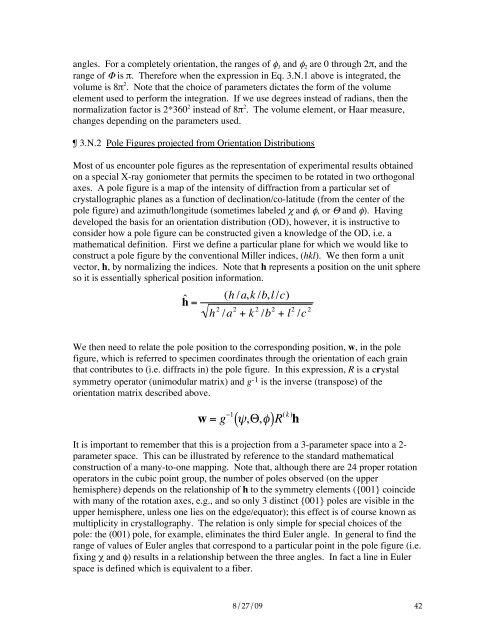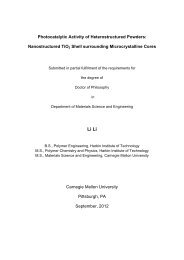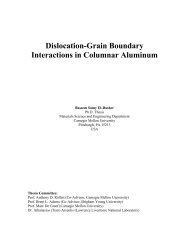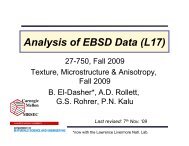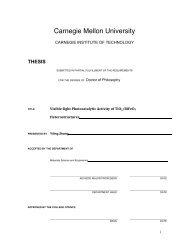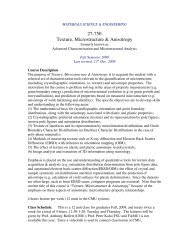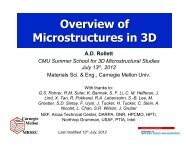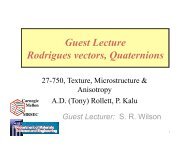¶ 3. Mathematical Representation of Crystal Orientation, Misorientation
¶ 3. Mathematical Representation of Crystal Orientation, Misorientation
¶ 3. Mathematical Representation of Crystal Orientation, Misorientation
You also want an ePaper? Increase the reach of your titles
YUMPU automatically turns print PDFs into web optimized ePapers that Google loves.
angles. For a completely orientation, the ranges <strong>of</strong> φ 1 and φ 2 are 0 through 2π, and the<br />
range <strong>of</strong> Φ is π. Therefore when the expression in Eq. <strong>3.</strong>N.1 above is integrated, the<br />
volume is 8π 2 . Note that the choice <strong>of</strong> parameters dictates the form <strong>of</strong> the volume<br />
element used to perform the integration. If we use degrees instead <strong>of</strong> radians, then the<br />
normalization factor is 2*360 2 instead <strong>of</strong> 8π 2 . The volume element, or Haar measure,<br />
changes depending on the parameters used.<br />
<strong>3.</strong>N.2 Pole Figures projected from <strong>Orientation</strong> Distributions<br />
Most <strong>of</strong> us encounter pole figures as the representation <strong>of</strong> experimental results obtained<br />
on a special X-ray goniometer that permits the specimen to be rotated in two orthogonal<br />
axes. A pole figure is a map <strong>of</strong> the intensity <strong>of</strong> diffraction from a particular set <strong>of</strong><br />
crystallographic planes as a function <strong>of</strong> declination/co-latitude (from the center <strong>of</strong> the<br />
pole figure) and azimuth/longitude (sometimes labeled χ and φ, or Θ and φ). Having<br />
developed the basis for an orientation distribution (OD), however, it is instructive to<br />
consider how a pole figure can be constructed given a knowledge <strong>of</strong> the OD, i.e. a<br />
mathematical definition. First we define a particular plane for which we would like to<br />
construct a pole figure by the conventional Miller indices, (hkl). We then form a unit<br />
vector, h, by normalizing the indices. Note that h represents a position on the unit sphere<br />
so it is essentially spherical position information.<br />
ˆ<br />
h =<br />
(h /a,k /b,l /c)<br />
h 2 /a 2 + k 2 /b 2 + l 2 /c 2<br />
We then need to relate the pole position to the corresponding position, w, in the pole<br />
figure, which is € referred to specimen coordinates through the orientation <strong>of</strong> each grain<br />
that contributes to (i.e. diffracts in) the pole figure. In this expression, R is a crystal<br />
symmetry operator (unimodular matrix) and g-1 is the inverse (transpose) <strong>of</strong> the<br />
orientation matrix described above.<br />
€<br />
w = g −1 ( ψ,Θ,φ )R (k) h<br />
It is important to remember that this is a projection from a 3-parameter space into a 2parameter<br />
space. This can be illustrated by reference to the standard mathematical<br />
construction <strong>of</strong> a many-to-one mapping. Note that, although there are 24 proper rotation<br />
operators in the cubic point group, the number <strong>of</strong> poles observed (on the upper<br />
hemisphere) depends on the relationship <strong>of</strong> h to the symmetry elements ({001} coincide<br />
with many <strong>of</strong> the rotation axes, e.g., and so only 3 distinct {001} poles are visible in the<br />
upper hemisphere, unless one lies on the edge/equator); this effect is <strong>of</strong> course known as<br />
multiplicity in crystallography. The relation is only simple for special choices <strong>of</strong> the<br />
pole: the (001) pole, for example, eliminates the third Euler angle. In general to find the<br />
range <strong>of</strong> values <strong>of</strong> Euler angles that correspond to a particular point in the pole figure (i.e.<br />
fixing χ and φ) results in a relationship between the three angles. In fact a line in Euler<br />
space is defined which is equivalent to a fiber.<br />
8/27/09 42


